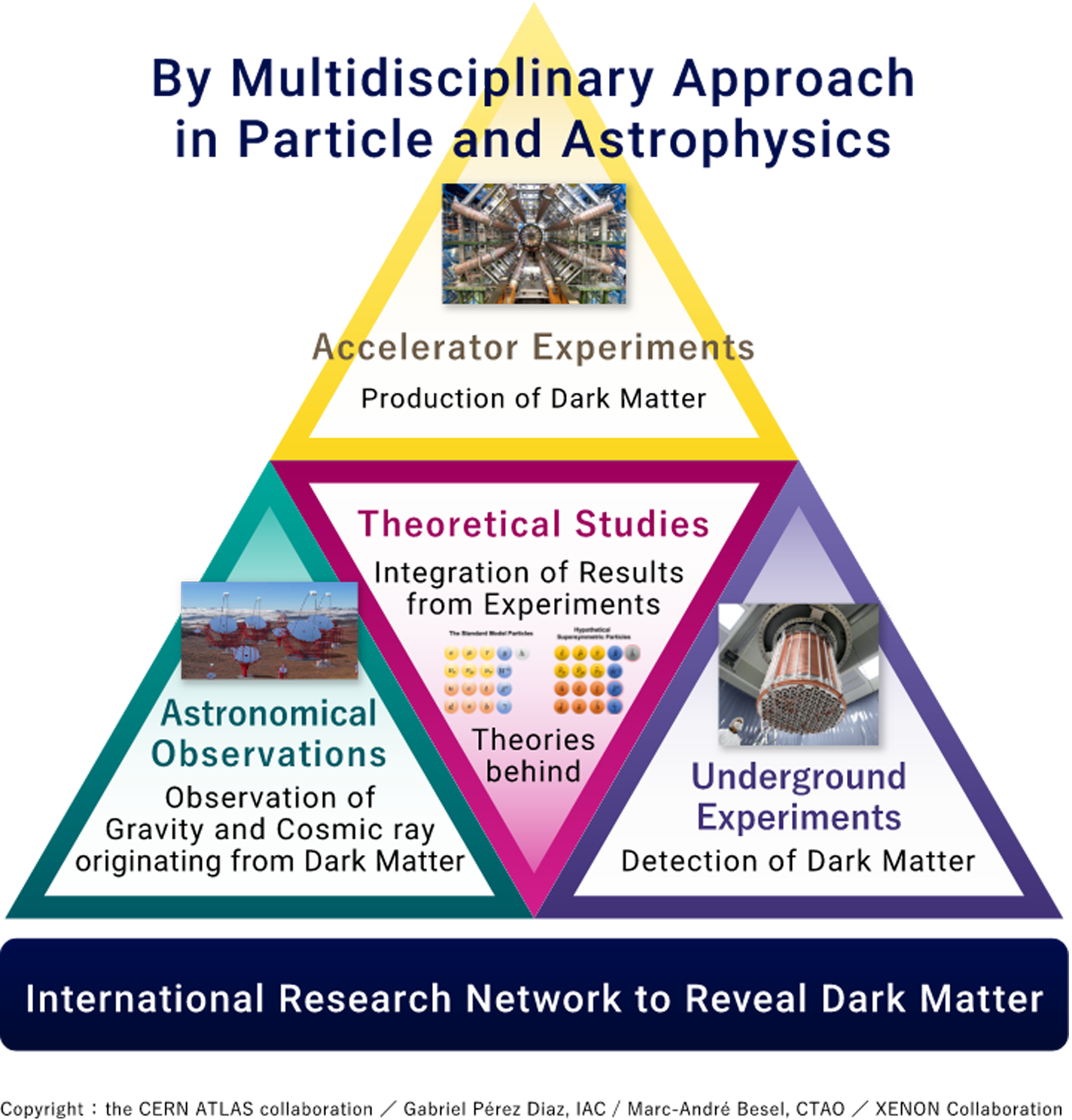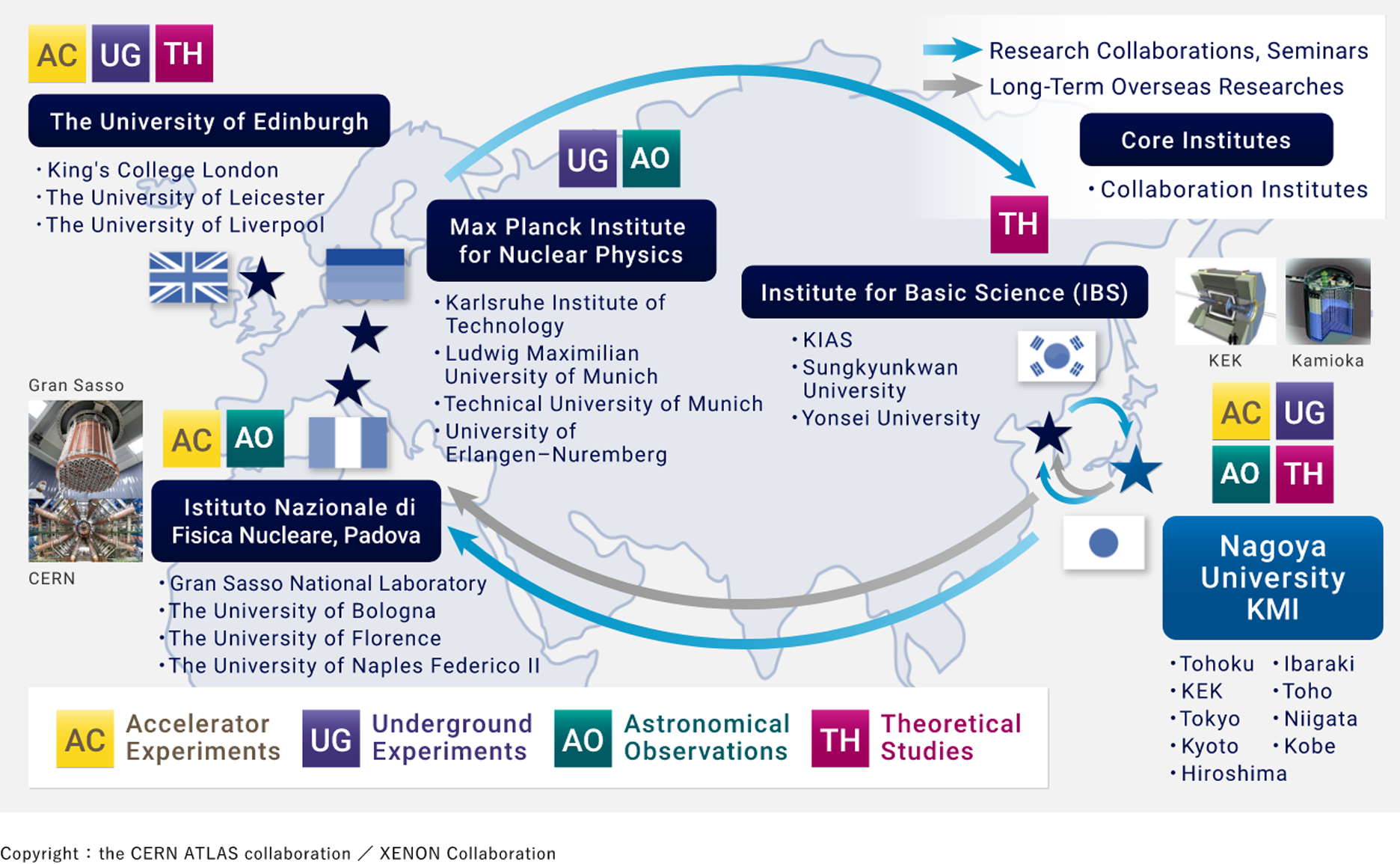目的・概要
About DMNet
宇宙の物質の大部分を占める暗黒物質は、正体は分かっていませんが、未知の素粒子であることがほぼ確実視されています。素粒子標準理論を超える新理論として有力とされている超対称性理論では、暗黒物質の候補として電気的に中性で重い未知の素粒子: Weakly Interacting Massive Particle(WIMP)の存在を予言しています。暗黒物質の特定はそれ自身大きな発見ですが、新たな素粒子理論の証拠ともなる今世紀最大の発見となります。しかしLHC 等の加速器実験では、新たな素粒子理論の兆候は見つかっておらず、暗黒物質は陽子よりも軽い未知の素粒子や未発見の重いニュートリノの可能性もあります。様々な可能性がうずまく混沌とした状況の中で、実験と理論の両面において、宇宙分野と素粒子分野にまたがった領域横断的なアプローチが、暗黒物質の正体を突き止めるため必要不可欠です。
本研究交流計画では、世界中で急速に進展している (A) 加速器実験、(B) 地下実験、(C) 宇宙観測、(D) 理論研究の四分野における暗黒物質研究を融合する国際研究拠点を、名古屋大学素粒子宇宙起源研究所: Kobayashi-Maskawa Institute (KMI)に構築します。国立核物理研究所 (INFN)(イタリア)、マックスプランク核物理研究所(ドイツ)、エジンバラ大学(英国) 、基礎科学研究所(韓国)を各国の主要拠点として連携し、さらに欧州の実験施設(CERN、グランサッソー研究所)と国内実験施設(高エネルギー加速器研究機構、東京大学宇宙線研究所神岡地下施設)を結びつけ、多彩な暗黒物質研究を実施します。この国際研究交流拠点の間で若手研究者の往還を行い、分野と国境を超えた若手人材育成ネットワークを形成し、(E) 将来構想・技術開発にあたってもらいます。このネットワークは、将来の暗黒物質研究の構想を育むゆりかごとなり、国際大型研究化が進む暗黒物質研究の将来計画の母体となります。
Dark matter accounts for most of the matter in the universe, while its nature is still unknown. It is expected by many researchers that it is an unknown elementary particle. The supersymmetric theory, which is a promising theory beyond the Standard Model (SM) of elementary particles, predicts the existence of an electrically neutral and heavy unknown elementary particle: Weakly Interacting Massive Particle (WIMP) as a candidate for dark matter. The identification of dark matter would be a major discovery in its own right, but it should be also the largest discovery of this century that is proof of a theory beyond the SM. However, no sign of theory beyond the SM has been found in accelerator experiments such as LHC, and dark matter might be unknown elementary particles lighter than protons or undiscovered heavy neutrinos. In this chaotic situation of various possibilities, a cross-disciplinary approach that spans particle and astroparticle physics, both experimentally and theoretically, is essential for determining the true nature of dark matter.
In this program, Kobayashi-Maskawa Institute for Origin of Particles and the Universe (KMI), Nagoya University is a core institute of dark matter research, and we integrate dark matter research in the four fields; (A) accelerator experiments, (B) underground experiments, (C) space observations, and (D) theoretical studies. National Institute for Nuclear Physics (INFN) in Italy, Max Planck Institute for Nuclear Physics in Germany, the University of Edinburgh in England, Institute for Basic Science (IBS) in Korea are collaborating with us as core institutes in each country. Various dark matter researches are being performed at European experimental facilities (CERN and Gran Sasso National Laboratory) and domestic experimental facilities (High Energy Accelerator Research Organization (KEK) and Kamioka Observatory, Institute for Cosmic Ray Research, The University of Tokyo). We send young researchers back and forth between these institutes to form a young human resource network across fields and national borders, and will invite them to (E) future plans and technology development for dark matter research. This network will be the basis of future plans for dark matter research, which is advancing into large-scale international research.
実施体制の概念
Concept of the DMNet implementation system
In Japanese.

In English.

研究交流の概念
Concept of research exchanges in DMNet
In Japanese.

In English.

